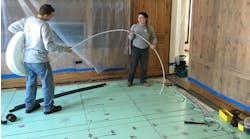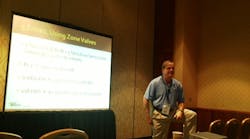ORLANDO, FLA. — This year at ACCA 2013, Feb. 27-March 1, in Orlando, Fla., contractors had the opportunity to attend Radiant and Hydronics Learning Labs, focusing on the history of radiant, how to integrate radiant into an HVAC business, and how to estimate fuel and electrical costs in residential hydronic systems.
“When this skyscraper was built it was the most advanced technology,” said Holohan. “This was the first time I ever saw radiant cooling. And near this ecological building happens to be the first ever radiant heating system — the hypocaust — by the Romans.”
Holohan then gave attendees a radiant history lesson in which he discussed the Kang Heater, which many homes are heated with in China, the Royal Liver Building in Liverpool, England, which was the first building to use radiant in the modern era (1911); how polyethylene was discovered and helped win WWII; the Usonian House, which Frank Lloyd Wright — one of the first architects in America to use radiant — designed; and how the 1956 Federal Aid Highway Act played a part in the decline of hydronics.
“Prior to WWII, 50% of buildings were steam or hot water heated,” said Holohan. “But people started moving out of the city, so that is when we begin to see a lot of track housing, which uses hot air. It’s cheaper. This is when we start to see hydronics fall off, and more furnaces are being used.”
At the end of his presentation, Holohan said that most people in the U.S. want to use the same ducts for heating and air conditioning, so the future of hydronics is in commercial.
Integrating hydronics
In the session Selling the Wet and Dry Sides Together,Dan Foley, owner and president of Foley Mechanical, discussed how contractors can have a successful business when combining heating and hydronics together.
“Radiant gives you additional work that is profitable,” said Foley. “I truly believe it is the most efficient for heat recovery, and it is very comfortable, which is the number one selling point. Our job is to provide comfort.”
So how does a contractor go about finding radiant projects? “Homeowners, manufacturers and local reps are sources,” said Foley. “Make sure the local reps know who you are. We also have a few key general contractors that we deal with. We also get work from the engineers that we know.” However, The No. 1 source of projects for Foley is architects that he works with on a regular basis.
Foley also mentioned that design and expertise is most important when selling a project.
“Focus on quality and craftsmanship, not price,” said Foley.
During the session Integrating Hydronics Into a Forced Air HVAC Business, Brian Stack, President of Stack Heating & Cooling, told contractors that they need to know their options and opportunities, and the importance of training.
“There is a lot of training available,” said Stack. “This is the most important step when adding hydronics to your business. First you need to know how things work and learn the basics of design. Find a manufacturer you are comfortable with and go to their training programs. They are all willing to help and offer great training.”
Stack also said that to grow a business contractors need to build up their alliances, such as with builders, remodelers and architects. It’s also important to attend home shows and network.
“Educate building remodelers of what your company can do, and talk to architects too,” said Stack. “Having solutions in your back pocket will help you grow. At home shows you can offer something different to the customer.”
Networking is of the utmost importance too.
“You have to talk to people,” said Stack. “If you are going into strictly retrofit work you need to position yourself as an expert. I personally think if the contractor truly wants to do a good job, building alliances in the industry is easy. There are not too many great hydronics contractors, and manufacturers are always excited when one comes along. Just showing interest and effort on the contractor’s part goes a long way. Also, once customers and other contractors find out you are the go to guy for hydronics, referrals come easy.”
In the session, Sun, Earth, Water & Fire, Bob Rohr, the educational and training manager for Caleffi, North America, spoke about passive homes, solar thermal, solar PV and geothermal, and how contractors can tap into these systems to grow their businesses.
“When you start seeing passive homes in Fine Homebuilding and Dwell magazines, and all of the Solar Decathlon entries, it tells me architects and homebuyers are taking notice,” said Rohr.
He added that fuel costs and the “green” movement drive some of this interest.
“I really think the X and Y generation homebuyers will pay more attention to passive and efficient home construction,” said Rohr. “Recent articles show remodel contractors are offering passive designs and additions, even in the city areas. So it is a market for folks that want to stay in their current homes also.”
Rohr told attendees that contractors wanting to gain experience in these markets need to take classes and network.
“The savvy HVAC contractor will take notice of these trends and seek out the products that fit well into the next generation home,” said Rohr. “Look to see who is sponsoring the Decathlon homes to find manufacturers that are ahead of this curve.”
Estimating fuel, electrical costs
In John Barba’s session, attendees learned about selling efficiency and estimating fuel and electrical costs in residential hydronic systems. Barba, education and training manager at Taco, discussed ROI and payback.
Barba then discussed why it is necessary to estimate fuel consumption.
“You do this to demonstrate the value of upgrades,” said Barba. “Show what the customer pays now instead of what the customer will pay in the future.
“No one can predict the future,” added Barba. “It’s impossible with any certainty to say, ‘This is what you're going to spend next year,’ because the upcoming winter may be a lot colder, or they may decide that since they have new, efficient equipment they can keep the house at 72 degrees instead of 68 degrees. And if your projections are off, just a little, it may come back to haunt you. When you look backwards you're basically comparing what they did spend last year to what they could have spent last year with upgraded equipment.”
Once a contractor has investigated the customer’s wants and needs — finding out what’s important to them, and what they’re hoping to get from the new equipment — and has estimates, it’s time to sit down with the customer and explain their options. During this process the contractor needs to point out tangibles, such as the comfort advantages.
“I think it's always beneficial to offer the customer a good-better-best set of options, and explain what they get and what they don't get with each option,” said Barba. “Then let the customer decide.”




